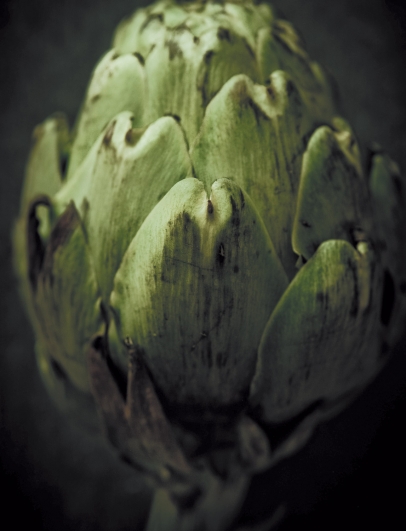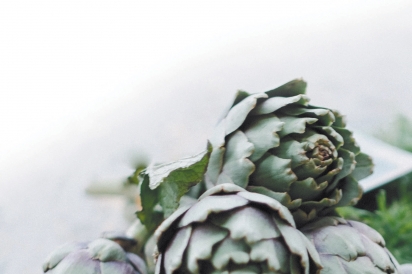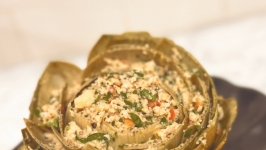What’s in Season Artichokes
California may be the artichoke capital of the United States, but the thorny thistle is a centuries-old vegetable favorite throughout the Mediterranean. The similarity of climates here and there makes the artichoke a natural to grow, and consume, in both. Throughout the Mediterranean region, you will find it cooked in dozens of ways, from deep fried to steamed and stuffed. It’s even eaten raw.
In addition to being eaten in various ways, the artichokes of the Mediterranean vary in size, shape and color. Some are thornless and globe shaped, others pyramid shaped. Some are purple, some are dark green, others lighter green. Leaves may be pointed, round, or indented, thorny or thornless.
In Tunisia, the favored varieties are Violette d’Hyres and Blanc d’Oran. In Provence, it’s Violette de Provence, sold on long stems like bunches of flowers. Italy has numerous regional and local favorites. The round Cimaroli or Mammelo, with a small choke, is the preferred variety in Rome, while the thorny, spikey variety is the pride of Sardinia. In Navarre, a northern province in Spain, the dominant variety is Blanca de Tudela, shipped all over the country. Turkey, Malta, Morocco, Egypt, Syria—the entirety of the countries bordering the Mediterranean and where artichokes grow so prolifically—have their favorite varieties and ways of cooking them.
When in Rome, the two artichoke dishes that top the lists of must-haves are the classic CarciofiGiudia, wherein the artichoke is trimmed and hollowed, then deep fried. Once the leaves turn golden, the artichokes are hit against each other, face to face, to flatten them out and open the leaves, before a second deep-fry that turns the leaves into crispy chips. The other Roman classic retains the long stem, tucks herbs between the leaves and braises the vegetable, cut side down, until tender.
In Provence and elsewhere, when fava beans come into season at the same time as artichokes, the latter, trimmed down to the heart and the most tender inner leaves, is braised along with favas in a mixture of garlic, white wine, olive oil and fresh thyme.
Throughout the entire Mediterranean, stuffed artichokes are an important presentation. The stems are removed, the base trimmed flat so the vegetable sits upright. Sometimes the artichokes are cooked first and then stuffed, or sometimes they are stuffed and then cooked. Stuffings might include bread and olives, anchovies, herbs, cheeses—every region has its specialties. In another version, the vessel to be stuffed might be just the artichoke bottom or fond. In this case, the artichoke’s leaves are removed, the choke is scooped out to create a hollow, and the outer edges are trimmed and smoothed. The chokes may be steamed before being filled with other ingredients, like seasoned crab and a bechamel sauce and baked, or they might be filled and baked.
Grow Your Own
Although we are half a world away from the Mediterranean Sea, our greater Bay Area has a similar climate, which means we can grow artichokes in our back—or front—yard. Perennials, the plants put out buds each spring, flowering in the late spring and summer before going dormant in winter. A central bud forms, then side shoots put out six, eight, even more buds over the course of the growing period, which are typically smaller than the first central bud.
With an artichoke plant or two, you’ll have plenty of the buds to experiment with cooking dishes from around the Mediterranean every spring. Once the weather becomes warmer, the chokes of buds left on the plants burst open to display a bright purple flower—the thistle—that are gorgeous to cut and bring inside to display decoratively.







